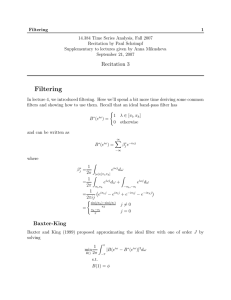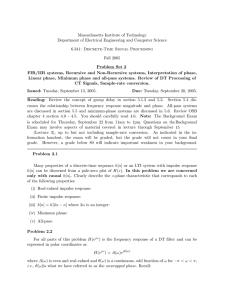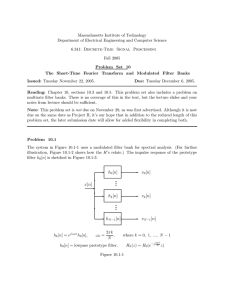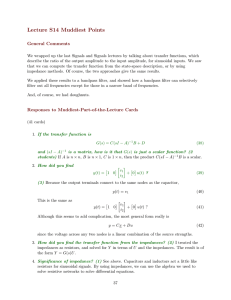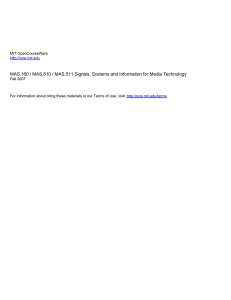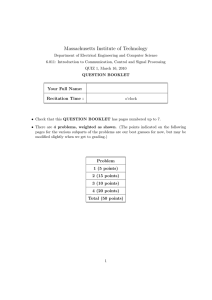2.161 Signal Processing: Continuous and Discrete MIT OpenCourseWare rms of Use, visit: .
advertisement
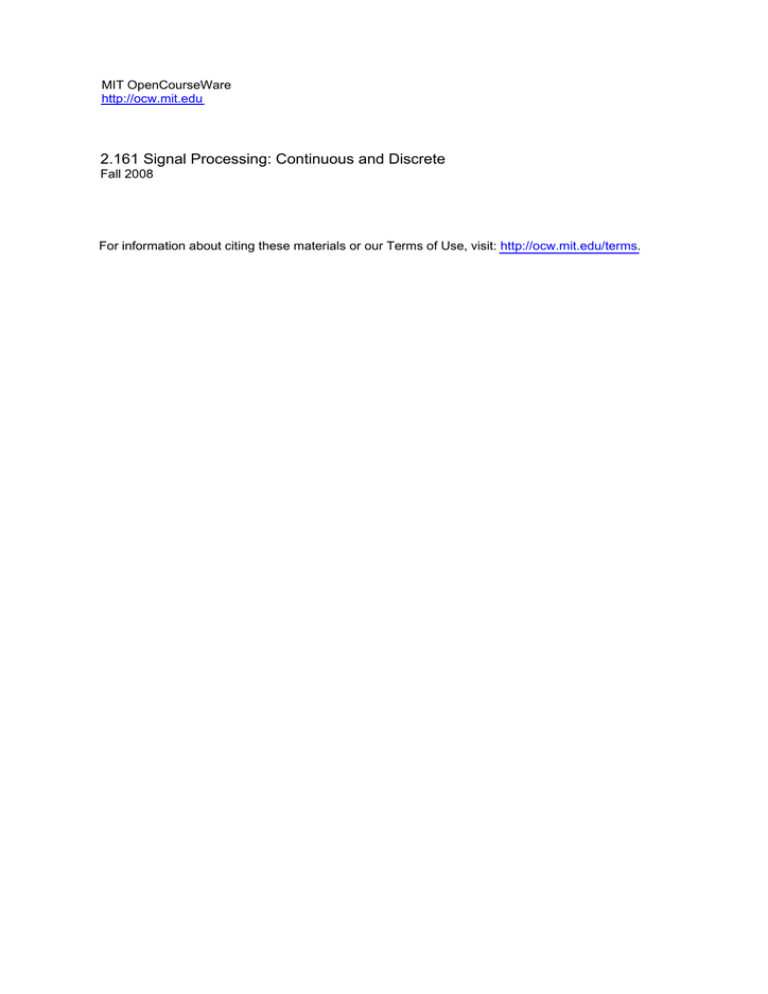
MIT OpenCourseWare
http://ocw.mit.edu
2.161 Signal Processing: Continuous and Discrete
Fall 2008
For information about citing these materials or our Terms of Use, visit: http://ocw.mit.edu/terms.
Massachusetts Institute of Technology
Department of Mechanical Engineering
2.161 Signal Processing - Continuous and Discrete
Fall Term 2008
Lecture 171
Reading:
1
•
Class Handout: Frequency-Sampling Filters.
•
Proakis and Manolakis: Secs. 10.2.3, 10.2.4
•
Oppenheim, Schafer and Buck: 7.4
•
Cartinhour: Ch. 9
Frequency-Sampling Filters
In the frequency-sampling filters the parameters that characterize the the filter are the
values of the desired frequency response H(ejω ) at a discrete set of equally spaced sampling
frequencies. In particular, let
ωk =
2π
k
N
k = 0, . . . , N − 1
(1)
as shown below for the cases of N even, and N odd. Note that when N is odd there is
no sample at the Nyquist frequency, ω = π. The frequency-sampling method guarantees
that the resulting filter design will meet the given design specification at each of the sample
frequencies.
Im (z )
Im (z )
z - p la n e
z - p la n e
M 2 F
1 0
-1
1
M
R e (z )
2 F
1 1
-1
N = 1 0 (e v e n )
1
c D.Rowell 2008
copyright 17–1
1
R e (z )
N = 1 1 (o d d )
(b )
(a )
For convenience denote the complete sample set {Hk } as
Hk = H(ejωk )
k = 1, . . . , N − 1.
For a filter with a real impulse response {hn } we require conjugate symmetry, that is
¯k
HN −k = H
and further, for a filter with a real, even impulse response we require {Hk } to be real and
even, that is
HN −k = Hk .
Within these constraints, it is sufficient to specify frequency samples for the upper half of
the z-plane, that is for
2π
k = 0, . . . , N 2−1
N odd
k
ωk =
N
N even.
k = 0, . . . , 2
N
and use the symmetry constraints to determine the other samples.
If we assume that H(ejω ) may be recovered from the complete sample set {Hk } by the
cardinal sinc interpolation method, that is
H(ejω ) =
N
−1
Hk
k=0
sin (ω − 2πk/N )
ω − 2πk/N
then H(ejω ) is completely specified by its sample set, and the impulse response, of length
N , may be found directly from the inverse DFT,
{hn } = IDFT {Hk }
where
N −1
2πkn
1 hn =
Hk ej N
N k=0
n = 0, . . . , N − 1
As mentioned above, this method guarantees that the resulting FIR filter, represented by
{hn }, will meet the specification H(ejω ) = Hk at ω = ωk = 2kπ/N . Between the given
sampling frequencies the response H(ejω ) will be described by the cardinal interpolation.
1.1
Linear-Phase Frequency-Sampling Filter
The filter described above is finite, with length N , but is non-causal. To create a causal filter
with a linear phase characteristic we require an impulse response that is real and symmetric
about its mid-point. This can be done by shifting the computed impulse response to the
right by (N − 1)/2 samples to form
H (z) = z −(N −1)/2 H(z)
but this involves a non-integer shift for even N . Instead, it is more convenient to add the
appropriate phase taper to the frequency domain samples Hk before taking the IDFT. The
non-integer delay then poses no problems:
17–2
• Apply a phase shift of
πk(N − 1)
N
to each of the samples in the upper half z-plane
k = 0, . . . , (N − 1)/2
jφk
Hk = Hk e
k = 0, . . . , N/2
φk = −
(2)
(for n odd)
(for n even)
• Force the lower half plane samples to be complex conjugates.
k = 1, . . . , (N − 1)/2
(for n odd)
HN −k = H̄k
k = 1, . . . , N/2 − 1
(for n even)
• Then the linear-phase impulse response is
{hn } = IDFT {Hk }
1.2
A Simple MATLAB Frequency-Sampling Filter
The following is a MATLAB script of a tutorial frequency-sampling filter
h = firfs(samples)
that takes a vector samples of length N of the desired frequency response in the range
0 ≤ ω ≤ (N − 1)π/N , and returns the linear-phase impulse response {hn } of length 2N − 1.
------------------------------------------------------------------------% 2.161 Classroom Example - firfs - A simple Frequency-Sampling Linear-Phase FIR
%
Filter based on DFT interpolation.
% Usage :
h = firfs(samples)
%
where samples - is a row vector of M equi-spaced, real values
%
of the freq. response magnitude.
%
The samples are interpreted as being equally spaced around
%
the top half of the unit circle at normalized (in terms of
%
the Nyquist frequency f_N) frequencies from
%
0 to 2(M-1)/(2M-1) x f_N,
%
or at frequencies 2k/(2N-1)xf_N for k = 0...M-1
%
Note: Because the length is odd, the frequency response
%
is not specified at f_N.
%
h - is the output impulse response of length 2M-1 (odd).
%
The filter h is real, and has linear phase, i.e. has symmetric
%
coefficients obeying h(k) = h(2M+1-k), k = 1,2,...,M+1.
%------------------------------------------------------------------------­
function h = firfs(samples)
%
% Find the length of the input array...
% The complete sample set on the unit circle will be of length (2N-1)
17–3
%
N = 2*length(samples) -1;
H_d = zeros(1,N);
%
% We want a causal filter, so the resulting impulse response will be shifted
% (N-1)/2 to the right.
% Move the samples into the upper and lower halves of H_d and add the
% linear phase shift term to each sample.
%
Phi = pi*(N-1)/N;
H_d(1) = samples(1);
for j = 2:N/2-1
Phase
= exp(-i*(j-1)*Phi);
H_d(j)
= samples(j)*Phase;
H_d(N+2-j)
= samples(j)*conj(Phase);
end
%
% Use the inverse DFT to define the impulse response.
%
h = real(ifft(H_d));
The following MATLAB commands were used to generate a filter with 22 frequency samples,
generating a length 43 filter.
h=firfs([1 1 1 1 0.4 0 0 0 0 0.8 2 2 2 2 0.8 0 0 0 0 0 0 0 ]);
freqz(h,1)
The filter has two pass-bands; a low-pass region with a gain of unity, and a band-pass region
with a gain of two. Notice that the band-edges have been specified with transition samples,
this is discussed further below. The above commands produced the following frequency
response for the filter.
Magnitude (dB)
0
−20
−40
−60
−80
0
0.1
0.2
0.3
0.4
0.5
0.6
0.7
Normalized Frequency ( π rad/sample)
0.8
0.9
1
0
0.1
0.2
0.3
0.4
0.5
0.6
0.7
Normalized Frequency ( π rad/sample)
0.8
0.9
1
Phase (degrees)
0
−500
−1000
−1500
−2000
17–4
1.3
The Effect of Band-Edge Transition Samples
One of the advantages of the frequency-sampling filter is that the band-edges may be more
precisely specified than the window method. For example, low-pass filters might be specified
by
h = firfs([1 1 1 1 1 0.4 0 0 0 0 0 0]);
with one transition value of 0.4, or
h = firfs([1 1 1 1 0.7 0.2 0 0 0 0 0 0]);
with a pair of transition specifications. The frequency-sampling filter characteristic will pass
through these points, and they can have a significant effect on the stop-band characteristics
of the filter.
The figure below shows the effect of varying the value of a single transition point in a
filter of length N = 33.
10
t = 0.6
t = 0.4
t = 0.2
0
Magnitude (dB)
−10
−20
−30
−40
−50
−60
−70
−80
0
0.1
0.2
0.3
0.4
0.5
0.6
Frequency f/FN
0.7
0.8
0.9
1
The values shown are for t = 0.6, 0.4 and 0.2. There is clearly a significant improvement in
the stop-band attenuation for for the case t = 0.4.
Similarly the following figure compares the best of these single transition values (t = 0.4)
with a the response using two transition points (t1 = 0.59, t2 = 0.11). The filter using two
transition points shows a significant improvement in the stop-band over the single point case,
at the expense of the transition width.
10
t1 = .59, t2 = 0.11
t = 0.4
0
−10
Magnitude (dB)
−20
−30
−40
−50
−60
−70
−80
0
0.1
0.2
0.3
0.4
0.5
0.6
Frequency f/fN
17–5
0.7
0.8
0.9
1
Rabiner et al. (1970) did an extensive linear-programming optimization study to deter­
mine the optimum value of band edge transition values, and tabulated the results for even
and odd filters of different lengths. The results show that for one transition point topt ≈ 0.4,
and for two points topt ≈ 0.59, and 0.11.
2
FIR Filter Design Using Optimization
These methods allow much greater flexibility in the filter specification. In general they seek
the filter coefficients that minimize the error (in some sense) between a desired frequency
response Hd ( ej ω ) and the achieved frequency response H( ej ω ). The most common optimiza­
tion method is that due to Parks and McClellan (1972) and is widely available in software
filter design packages (including MATLAB).
The Parks-McClellan method allows
• Multiple pass- and stop-bands.
• Is an equi-ripple design in the pass- and stop-bands, but allows independent weighting
of the ripple in each band.
• Allows specification of the band edges.
tr a n s itio n
e q u i- r ip p le
1 + @
1
1
1 -@
1
p a s s - b a n d
s to p -b a n d
e q u i- r ip p le
@
0
2
M
M
c
F
s
M
For the low-pass filter shown above the specification would be
1 − δ1 < H( ej ω ) < 1 + δ1
−δ2 < H( ej ω ) < δ2
in the pass-band 0 < ω ≤ ωc
in the stop-band ωs < ω ≤ π.
where the ripple amplitudes δ1 and δ2 need not be equal. Given these specifications we need
to determine, the length of the filter M + 1 and the filter coefficients {hn } that meet the
specifications in some optimal sense.
If M + 1 is odd, and we assume even symmetry
hM −k = hk
k = 0 . . . M/2
17–6
and the frequency response function can be written
jω
H( e ) = h0 + 2
M/2
hk cos(ωk)
k=1
M/2
=
ak cos(ωk)
k=0
Let Hd ( ej ω ) be the desired frequency response, and define a weighted error
E( ej ω ) = W ( ej ω ) Hd ( ej ω ) − H( ej ω )
where W ( ej ω ) is a frequency dependent weighting function, but by convention let W ( ej ω )
be constant across each of the critical bands, and zero in all transition bands. In particular
for the low-pass design
⎧
⎪δ2 /δ1 in the pass-band
⎨
jω
W(e ) = 1
in the stop-band
⎪
⎩
0
in the transition band.
This states that the optimization will control the ratio of the pass-band to stop-band ripple,
and that the transition will not contribute to the error criterion.
Let Ω be a compact subset of the frequency band from 0 to π representing the pass- and
stop-bands. The goal is to find the set of filter parameters {ak }, k = 0, . . . , M/2 + 1 that
minimize the maximum value of the error E( ej ω ) over the pass- and stop-bands.
⎞⎤⎤
⎡
⎡
⎛
M/2
jω jω ⎝
jω
⎠
⎣
⎣
min max E( e )
= min max W ( e ) Hd ( e ) −
ak cos(ωk) ⎦⎦
over ak over Ω
over ak over Ω
k=0
where Ω is the disjoint set of frequency bands that make up the pass- and stop-bands of
the filter.
The solution is found by an iterative optimization routine. We do not attempt to cover the
details of the algorithm here, and merely note:
• The method is based on reformulating the problem as one in polynomial approximation,
using Chebyshev polynomials, where
cos(ωk) = Tk (cos(ω))
where Tk (x) is a polynomial of degree k, (see the Class Handout on Chebyshev filter
design). Consequently
jω
H( e ) =
M/2
ak cos(ωk) =
k=0
M/2
k=0
17–7
ak (cos(ω))k
• The algorithm uses Chebyshev’s alternation theorem to recognize the optimal solution.
In general terms the theorem is stated:
Define the error E(x) as above, namely
E( ej ω ) = W ( ej ω ) Hd ( ej ω ) − H( ej ω )
and the maximum error as
E( ej ω )∞ = argmaxx∈Ω E( ej ω )
A necessary and sufficient condition that H( ej ω ) is the unique Lth-order
polynomial minimizing E( ej ω )∞ is that E( ej ω ) exhibit at least L + 2
extremal frequencies, or “alternations”, that is there must exist at least L+2
values of ω, ωk ∈ Ω, k = [0, 1, . . . , L + 1], such that ω0 < ω1 < . . . < ωL+1 ,
and such that
E( ej ωk ) = −E( ej ωk+1 ) = ± E( ej ω )∞ .
Note that the alternation theorem is simply a way of recognizing the optimal equi­
ripple solution. For example, the following figure is from a Parks-McClellan low-pass
filter with length M + 1 = 17.
| H ( e j M ) |
1 + @
tr a n s itio n
1
1
1 -@
1
p a s s -b a n d
s to p -b a n d
a lte r n a tio n fr e q u e n c ie s
@
2
0
M
c
M
F
s
M
From above, H( ej ω ) is written as a polynomial of degree M/2,
jω
H( e ) =
M/2
ak (cos(ω))k
k=0
so that L = M/2 and the pass- and stop-bands must exhibit at least M/2 + 2 = 10
points of alternation. These 10 points are shown in the figure.
• The Parks-McClellan algoritm uses the Remez exchange optimization method.
17–8
See Proakis and Manolakis Sec. 10.2.4 or Openheim, Schafer and Buck Sec. 7.4 for details.
MATLAB Parks-McClellan Function: The Parks-McClellan algorithm is implemented
in the MATLAB function
b = firpm(M,F,A,W)
where b is the array of filter coefficients, M is the filter order (M+1 is the length of the filter),
F is a vector of band edge frequencies in ascending order, A is a set of filter gains at the band
edges, and W is an optional set of relative weights to be applied to each of the bands.
For example, consider a band-pass filter with two pass-bands as shown below:
H d (e
)
jM
p a s s
1
p a s s
0 .7
0
s to p
M
s to p
1
tr a n s itio n
M
M
2
3
tr a n s itio n
M
s to p
M
4
5
tr a n s itio n
M
M
6
7
tr a n s itio n
M
F
8
M
There are five distinct bands in this filter, separated by four transition regions. The filter
would require the following specifications:
F = [0 ω1 ω2 ω3 ω4 ω5 ω6 ω7 ω8 1]
A = [0 0 1 1 0 0 0.7 0.7 0 0]
W = [10 1 10 1 10]
where the errors in the stop-bands have been weighted 10 times more heavily than in the
pass-bands. See the MATLAB help/documentation for more details.
Example 1
Design a length 33 Parks-McClellan band-pass filter with the following band
specifications:
H d (e
jM
)
p a s s
1 0
0
s to p
0 .2 F
tr a n s itio n
s to p
0 .4 F
0 .7 F
17–9
tr a n s itio n
0 .8 5 F
F
M
Weight the stop-band ripple ten times more heavily than the pass-band.
Solution:
h=firpm(32,[0 0.2 0.4 0.7 0.85 1],[0 0 10 10 0 0],[10 1 10])
freqz(h,1)
M a g n itu d e ( d B )
5 0
0
-5 0
0
-1 0 0
P h a s e (d e g re e s )
1 0 0 0
0 .2
0 .4
N o r m a liz e d F r e q u e n c y
(x p
0 .2
0 .4
N o r m a liz e d F r e q u e n c y
(x p
0 .6
r a d /s a m p le )
0 .8
1
0 .8
1
5 0 0
0
-5 0 0
-1 0 0 0
-1 5 0 0
0
17–10
0 .6
r a d /s a m p le )



